Academique: BSBHRM501 Diploma of Human Resources Assignment
VerifiedAdded on 2022/10/06
|11
|2920
|13
Homework Assignment
AI Summary
This assignment delves into the core aspects of managing human resource services, using a case study of Art & Pasta to illustrate key concepts. It begins by outlining the organization's goals and business strategy, emphasizing the importance of fresh, quality ingredients and the adoption of local culture within the Australian food industry. The assignment then explores operational plans, highlighting the integration of human resource management with these plans. It also examines the external business environment, including political, economic, social, and technological factors, and their impact on HR needs. The document further discusses obtaining information from line and senior managers to identify HR needs, and the importance of workforce diversity. It proposes strategies to achieve an ideal state of diversity, emphasizing equal treatment and fair compensation. The assignment also covers various HR options, such as the use of contractors, and how these options align with business goals and legislative requirements. It addresses decision-making processes, the evolving roles of the HR team, and negotiation strategies for service level agreements. Finally, it identifies specific benchmarks for review processes, such as service specifications, timeframes, and performance standards, and provides an example of externally provided training, such as the Six Sigma methodology.
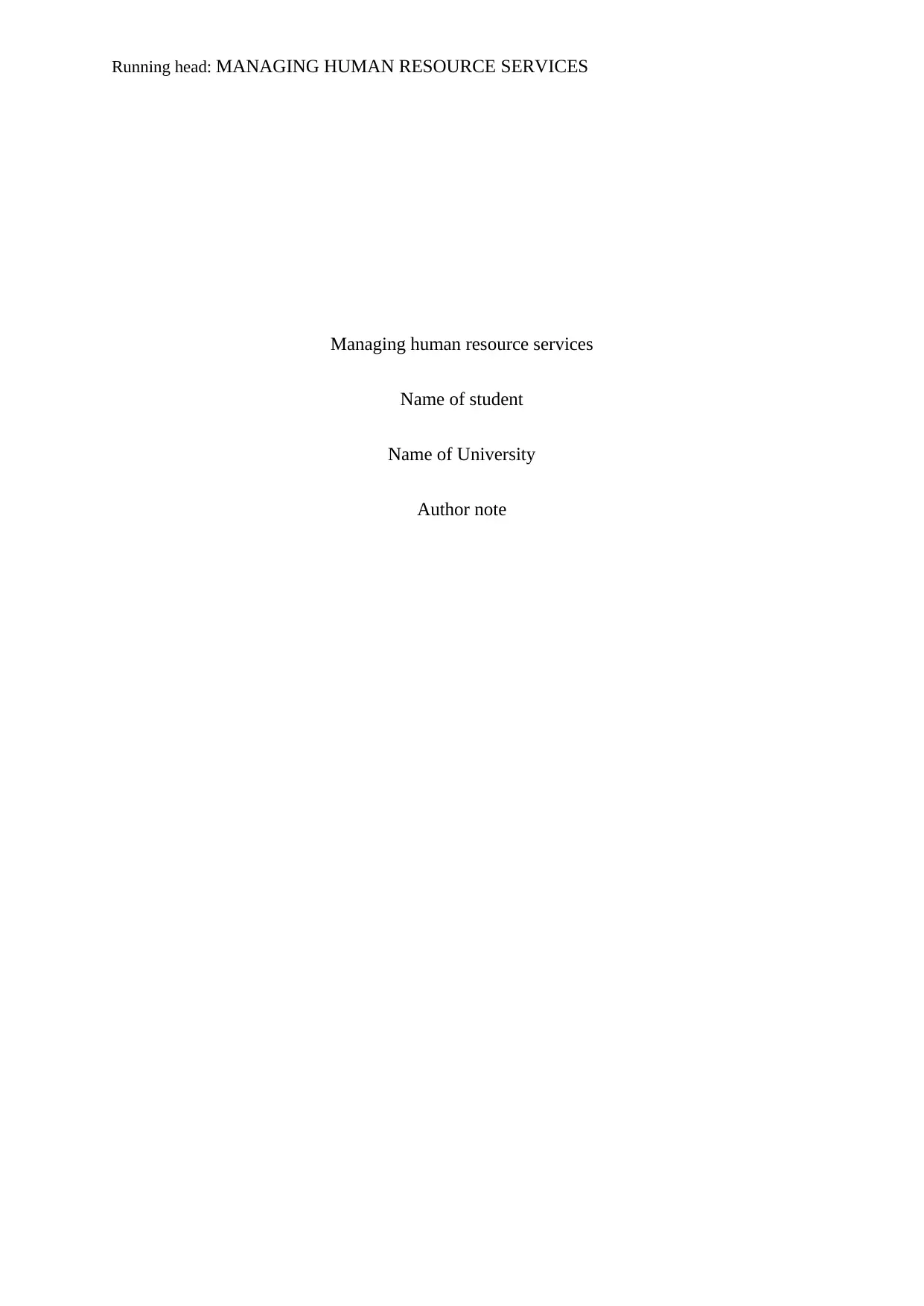
Running head: MANAGING HUMAN RESOURCE SERVICES
Managing human resource services
Name of student
Name of University
Author note
Managing human resource services
Name of student
Name of University
Author note
Paraphrase This Document
Need a fresh take? Get an instant paraphrase of this document with our AI Paraphraser
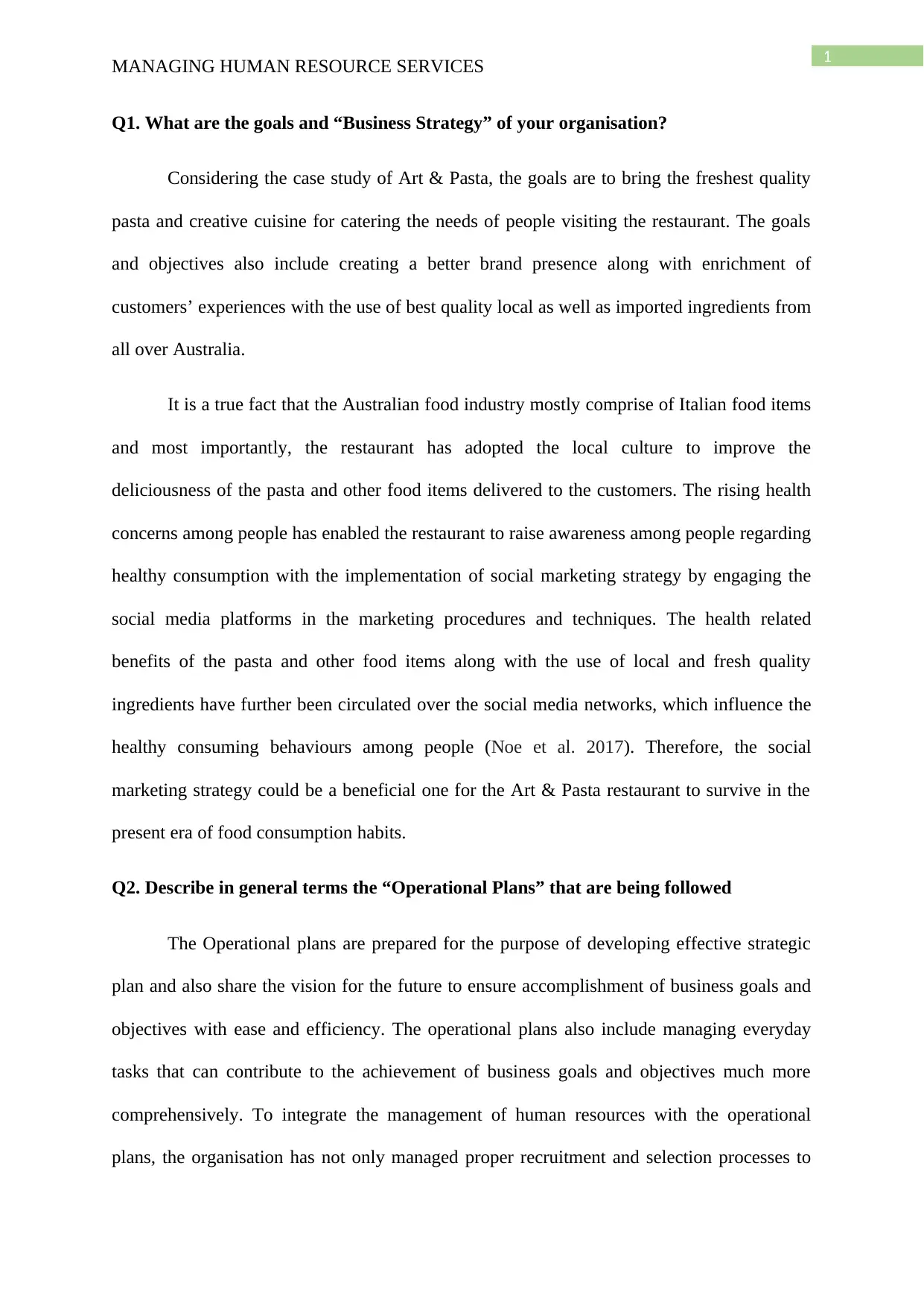
1
MANAGING HUMAN RESOURCE SERVICES
Q1. What are the goals and “Business Strategy” of your organisation?
Considering the case study of Art & Pasta, the goals are to bring the freshest quality
pasta and creative cuisine for catering the needs of people visiting the restaurant. The goals
and objectives also include creating a better brand presence along with enrichment of
customers’ experiences with the use of best quality local as well as imported ingredients from
all over Australia.
It is a true fact that the Australian food industry mostly comprise of Italian food items
and most importantly, the restaurant has adopted the local culture to improve the
deliciousness of the pasta and other food items delivered to the customers. The rising health
concerns among people has enabled the restaurant to raise awareness among people regarding
healthy consumption with the implementation of social marketing strategy by engaging the
social media platforms in the marketing procedures and techniques. The health related
benefits of the pasta and other food items along with the use of local and fresh quality
ingredients have further been circulated over the social media networks, which influence the
healthy consuming behaviours among people (Noe et al. 2017). Therefore, the social
marketing strategy could be a beneficial one for the Art & Pasta restaurant to survive in the
present era of food consumption habits.
Q2. Describe in general terms the “Operational Plans” that are being followed
The Operational plans are prepared for the purpose of developing effective strategic
plan and also share the vision for the future to ensure accomplishment of business goals and
objectives with ease and efficiency. The operational plans also include managing everyday
tasks that can contribute to the achievement of business goals and objectives much more
comprehensively. To integrate the management of human resources with the operational
plans, the organisation has not only managed proper recruitment and selection processes to
MANAGING HUMAN RESOURCE SERVICES
Q1. What are the goals and “Business Strategy” of your organisation?
Considering the case study of Art & Pasta, the goals are to bring the freshest quality
pasta and creative cuisine for catering the needs of people visiting the restaurant. The goals
and objectives also include creating a better brand presence along with enrichment of
customers’ experiences with the use of best quality local as well as imported ingredients from
all over Australia.
It is a true fact that the Australian food industry mostly comprise of Italian food items
and most importantly, the restaurant has adopted the local culture to improve the
deliciousness of the pasta and other food items delivered to the customers. The rising health
concerns among people has enabled the restaurant to raise awareness among people regarding
healthy consumption with the implementation of social marketing strategy by engaging the
social media platforms in the marketing procedures and techniques. The health related
benefits of the pasta and other food items along with the use of local and fresh quality
ingredients have further been circulated over the social media networks, which influence the
healthy consuming behaviours among people (Noe et al. 2017). Therefore, the social
marketing strategy could be a beneficial one for the Art & Pasta restaurant to survive in the
present era of food consumption habits.
Q2. Describe in general terms the “Operational Plans” that are being followed
The Operational plans are prepared for the purpose of developing effective strategic
plan and also share the vision for the future to ensure accomplishment of business goals and
objectives with ease and efficiency. The operational plans also include managing everyday
tasks that can contribute to the achievement of business goals and objectives much more
comprehensively. To integrate the management of human resources with the operational
plans, the organisation has not only managed proper recruitment and selection processes to
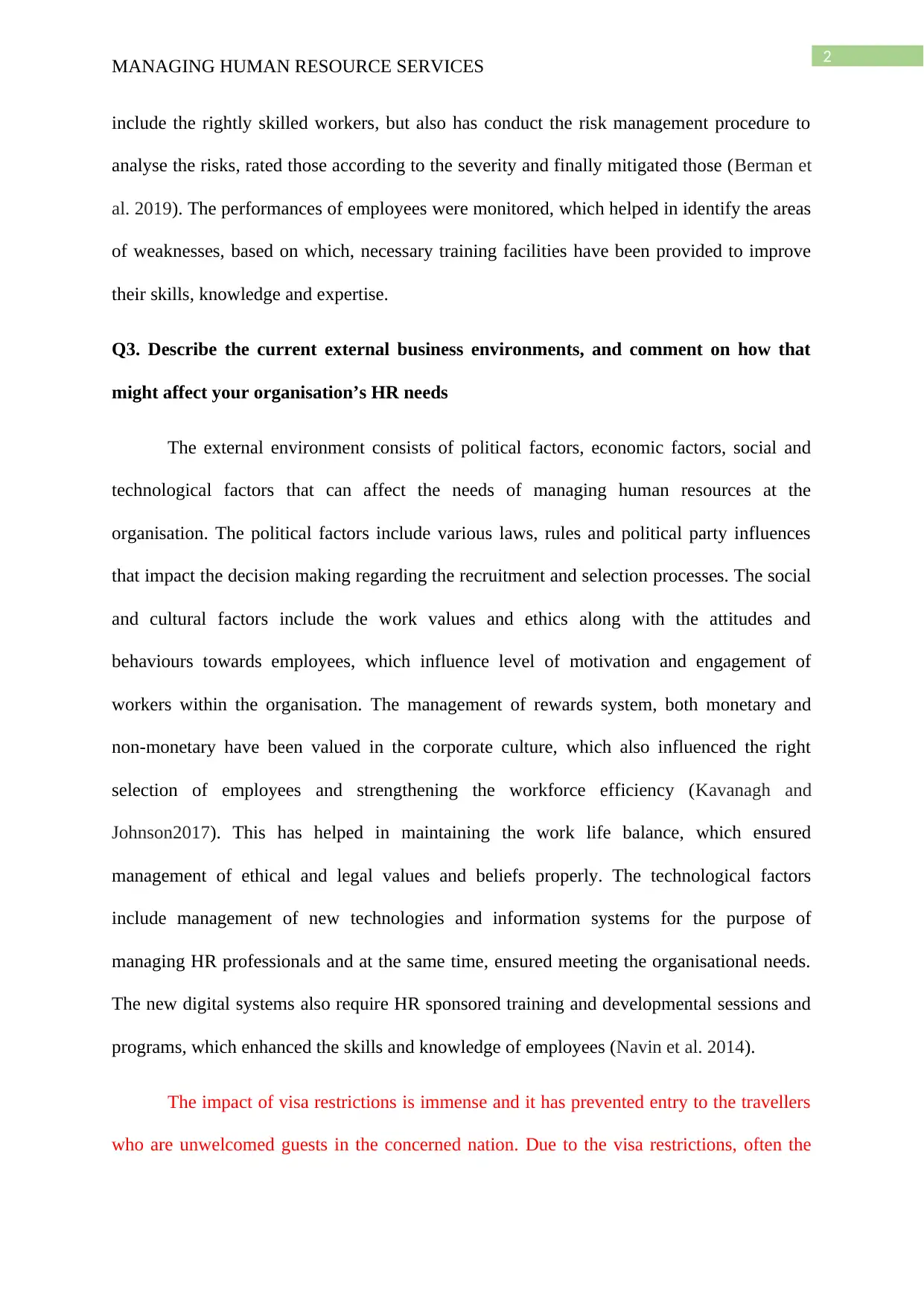
2
MANAGING HUMAN RESOURCE SERVICES
include the rightly skilled workers, but also has conduct the risk management procedure to
analyse the risks, rated those according to the severity and finally mitigated those (Berman et
al. 2019). The performances of employees were monitored, which helped in identify the areas
of weaknesses, based on which, necessary training facilities have been provided to improve
their skills, knowledge and expertise.
Q3. Describe the current external business environments, and comment on how that
might affect your organisation’s HR needs
The external environment consists of political factors, economic factors, social and
technological factors that can affect the needs of managing human resources at the
organisation. The political factors include various laws, rules and political party influences
that impact the decision making regarding the recruitment and selection processes. The social
and cultural factors include the work values and ethics along with the attitudes and
behaviours towards employees, which influence level of motivation and engagement of
workers within the organisation. The management of rewards system, both monetary and
non-monetary have been valued in the corporate culture, which also influenced the right
selection of employees and strengthening the workforce efficiency (Kavanagh and
Johnson2017). This has helped in maintaining the work life balance, which ensured
management of ethical and legal values and beliefs properly. The technological factors
include management of new technologies and information systems for the purpose of
managing HR professionals and at the same time, ensured meeting the organisational needs.
The new digital systems also require HR sponsored training and developmental sessions and
programs, which enhanced the skills and knowledge of employees (Navin et al. 2014).
The impact of visa restrictions is immense and it has prevented entry to the travellers
who are unwelcomed guests in the concerned nation. Due to the visa restrictions, often the
MANAGING HUMAN RESOURCE SERVICES
include the rightly skilled workers, but also has conduct the risk management procedure to
analyse the risks, rated those according to the severity and finally mitigated those (Berman et
al. 2019). The performances of employees were monitored, which helped in identify the areas
of weaknesses, based on which, necessary training facilities have been provided to improve
their skills, knowledge and expertise.
Q3. Describe the current external business environments, and comment on how that
might affect your organisation’s HR needs
The external environment consists of political factors, economic factors, social and
technological factors that can affect the needs of managing human resources at the
organisation. The political factors include various laws, rules and political party influences
that impact the decision making regarding the recruitment and selection processes. The social
and cultural factors include the work values and ethics along with the attitudes and
behaviours towards employees, which influence level of motivation and engagement of
workers within the organisation. The management of rewards system, both monetary and
non-monetary have been valued in the corporate culture, which also influenced the right
selection of employees and strengthening the workforce efficiency (Kavanagh and
Johnson2017). This has helped in maintaining the work life balance, which ensured
management of ethical and legal values and beliefs properly. The technological factors
include management of new technologies and information systems for the purpose of
managing HR professionals and at the same time, ensured meeting the organisational needs.
The new digital systems also require HR sponsored training and developmental sessions and
programs, which enhanced the skills and knowledge of employees (Navin et al. 2014).
The impact of visa restrictions is immense and it has prevented entry to the travellers
who are unwelcomed guests in the concerned nation. Due to the visa restrictions, often the
⊘ This is a preview!⊘
Do you want full access?
Subscribe today to unlock all pages.

Trusted by 1+ million students worldwide
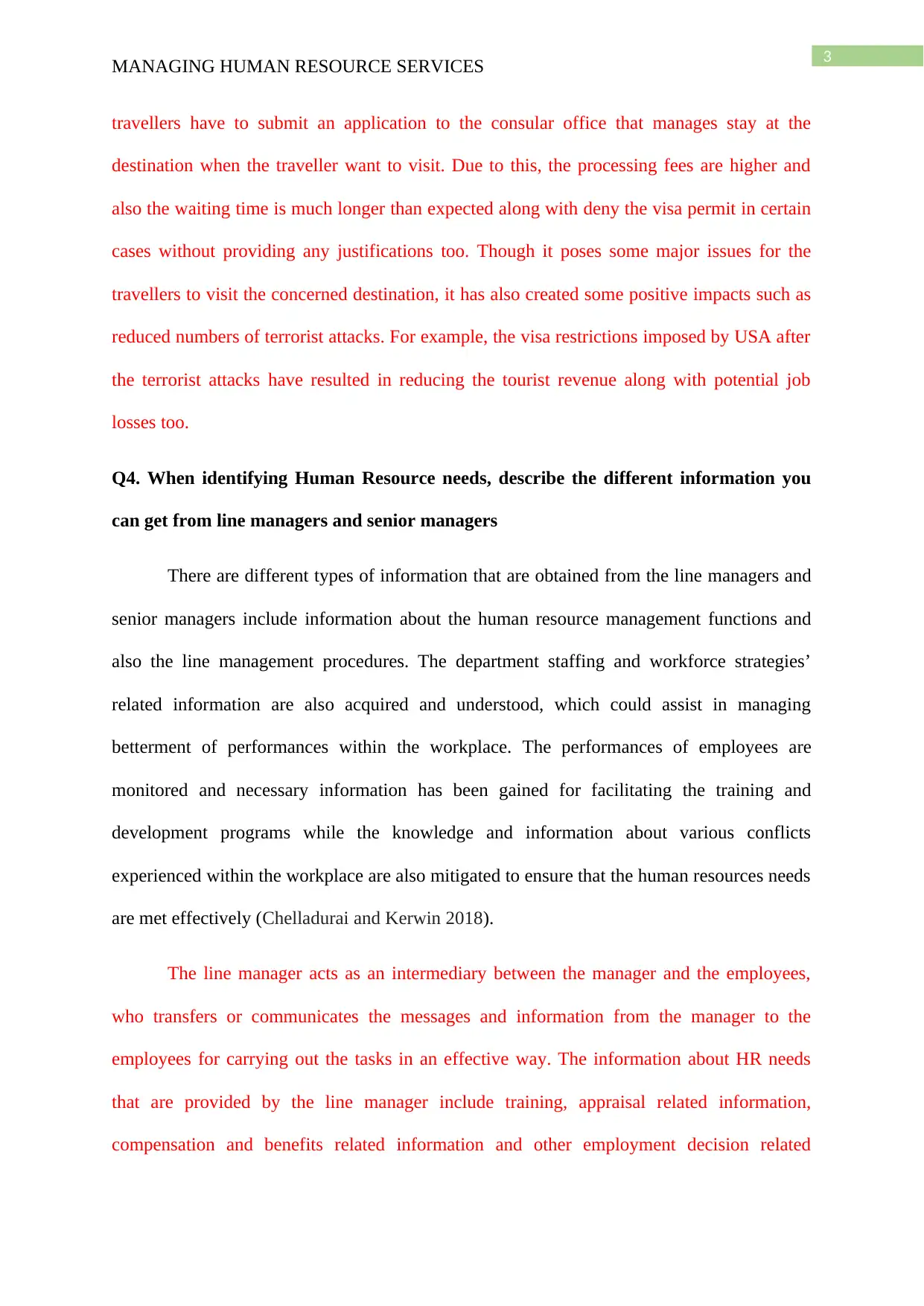
3
MANAGING HUMAN RESOURCE SERVICES
travellers have to submit an application to the consular office that manages stay at the
destination when the traveller want to visit. Due to this, the processing fees are higher and
also the waiting time is much longer than expected along with deny the visa permit in certain
cases without providing any justifications too. Though it poses some major issues for the
travellers to visit the concerned destination, it has also created some positive impacts such as
reduced numbers of terrorist attacks. For example, the visa restrictions imposed by USA after
the terrorist attacks have resulted in reducing the tourist revenue along with potential job
losses too.
Q4. When identifying Human Resource needs, describe the different information you
can get from line managers and senior managers
There are different types of information that are obtained from the line managers and
senior managers include information about the human resource management functions and
also the line management procedures. The department staffing and workforce strategies’
related information are also acquired and understood, which could assist in managing
betterment of performances within the workplace. The performances of employees are
monitored and necessary information has been gained for facilitating the training and
development programs while the knowledge and information about various conflicts
experienced within the workplace are also mitigated to ensure that the human resources needs
are met effectively (Chelladurai and Kerwin 2018).
The line manager acts as an intermediary between the manager and the employees,
who transfers or communicates the messages and information from the manager to the
employees for carrying out the tasks in an effective way. The information about HR needs
that are provided by the line manager include training, appraisal related information,
compensation and benefits related information and other employment decision related
MANAGING HUMAN RESOURCE SERVICES
travellers have to submit an application to the consular office that manages stay at the
destination when the traveller want to visit. Due to this, the processing fees are higher and
also the waiting time is much longer than expected along with deny the visa permit in certain
cases without providing any justifications too. Though it poses some major issues for the
travellers to visit the concerned destination, it has also created some positive impacts such as
reduced numbers of terrorist attacks. For example, the visa restrictions imposed by USA after
the terrorist attacks have resulted in reducing the tourist revenue along with potential job
losses too.
Q4. When identifying Human Resource needs, describe the different information you
can get from line managers and senior managers
There are different types of information that are obtained from the line managers and
senior managers include information about the human resource management functions and
also the line management procedures. The department staffing and workforce strategies’
related information are also acquired and understood, which could assist in managing
betterment of performances within the workplace. The performances of employees are
monitored and necessary information has been gained for facilitating the training and
development programs while the knowledge and information about various conflicts
experienced within the workplace are also mitigated to ensure that the human resources needs
are met effectively (Chelladurai and Kerwin 2018).
The line manager acts as an intermediary between the manager and the employees,
who transfers or communicates the messages and information from the manager to the
employees for carrying out the tasks in an effective way. The information about HR needs
that are provided by the line manager include training, appraisal related information,
compensation and benefits related information and other employment decision related
Paraphrase This Document
Need a fresh take? Get an instant paraphrase of this document with our AI Paraphraser
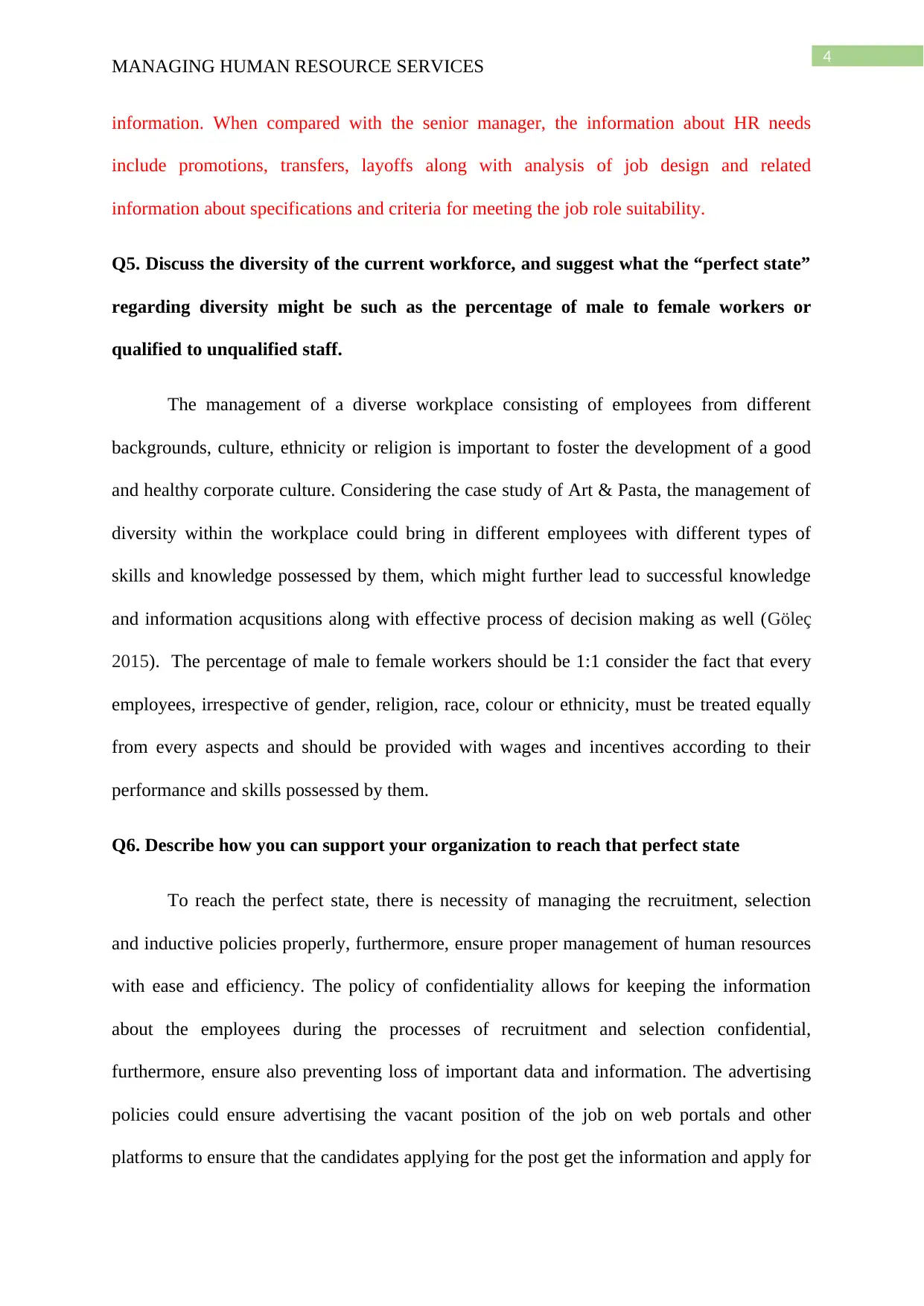
4
MANAGING HUMAN RESOURCE SERVICES
information. When compared with the senior manager, the information about HR needs
include promotions, transfers, layoffs along with analysis of job design and related
information about specifications and criteria for meeting the job role suitability.
Q5. Discuss the diversity of the current workforce, and suggest what the “perfect state”
regarding diversity might be such as the percentage of male to female workers or
qualified to unqualified staff.
The management of a diverse workplace consisting of employees from different
backgrounds, culture, ethnicity or religion is important to foster the development of a good
and healthy corporate culture. Considering the case study of Art & Pasta, the management of
diversity within the workplace could bring in different employees with different types of
skills and knowledge possessed by them, which might further lead to successful knowledge
and information acqusitions along with effective process of decision making as well (Göleç
2015). The percentage of male to female workers should be 1:1 consider the fact that every
employees, irrespective of gender, religion, race, colour or ethnicity, must be treated equally
from every aspects and should be provided with wages and incentives according to their
performance and skills possessed by them.
Q6. Describe how you can support your organization to reach that perfect state
To reach the perfect state, there is necessity of managing the recruitment, selection
and inductive policies properly, furthermore, ensure proper management of human resources
with ease and efficiency. The policy of confidentiality allows for keeping the information
about the employees during the processes of recruitment and selection confidential,
furthermore, ensure also preventing loss of important data and information. The advertising
policies could ensure advertising the vacant position of the job on web portals and other
platforms to ensure that the candidates applying for the post get the information and apply for
MANAGING HUMAN RESOURCE SERVICES
information. When compared with the senior manager, the information about HR needs
include promotions, transfers, layoffs along with analysis of job design and related
information about specifications and criteria for meeting the job role suitability.
Q5. Discuss the diversity of the current workforce, and suggest what the “perfect state”
regarding diversity might be such as the percentage of male to female workers or
qualified to unqualified staff.
The management of a diverse workplace consisting of employees from different
backgrounds, culture, ethnicity or religion is important to foster the development of a good
and healthy corporate culture. Considering the case study of Art & Pasta, the management of
diversity within the workplace could bring in different employees with different types of
skills and knowledge possessed by them, which might further lead to successful knowledge
and information acqusitions along with effective process of decision making as well (Göleç
2015). The percentage of male to female workers should be 1:1 consider the fact that every
employees, irrespective of gender, religion, race, colour or ethnicity, must be treated equally
from every aspects and should be provided with wages and incentives according to their
performance and skills possessed by them.
Q6. Describe how you can support your organization to reach that perfect state
To reach the perfect state, there is necessity of managing the recruitment, selection
and inductive policies properly, furthermore, ensure proper management of human resources
with ease and efficiency. The policy of confidentiality allows for keeping the information
about the employees during the processes of recruitment and selection confidential,
furthermore, ensure also preventing loss of important data and information. The advertising
policies could ensure advertising the vacant position of the job on web portals and other
platforms to ensure that the candidates applying for the post get the information and apply for
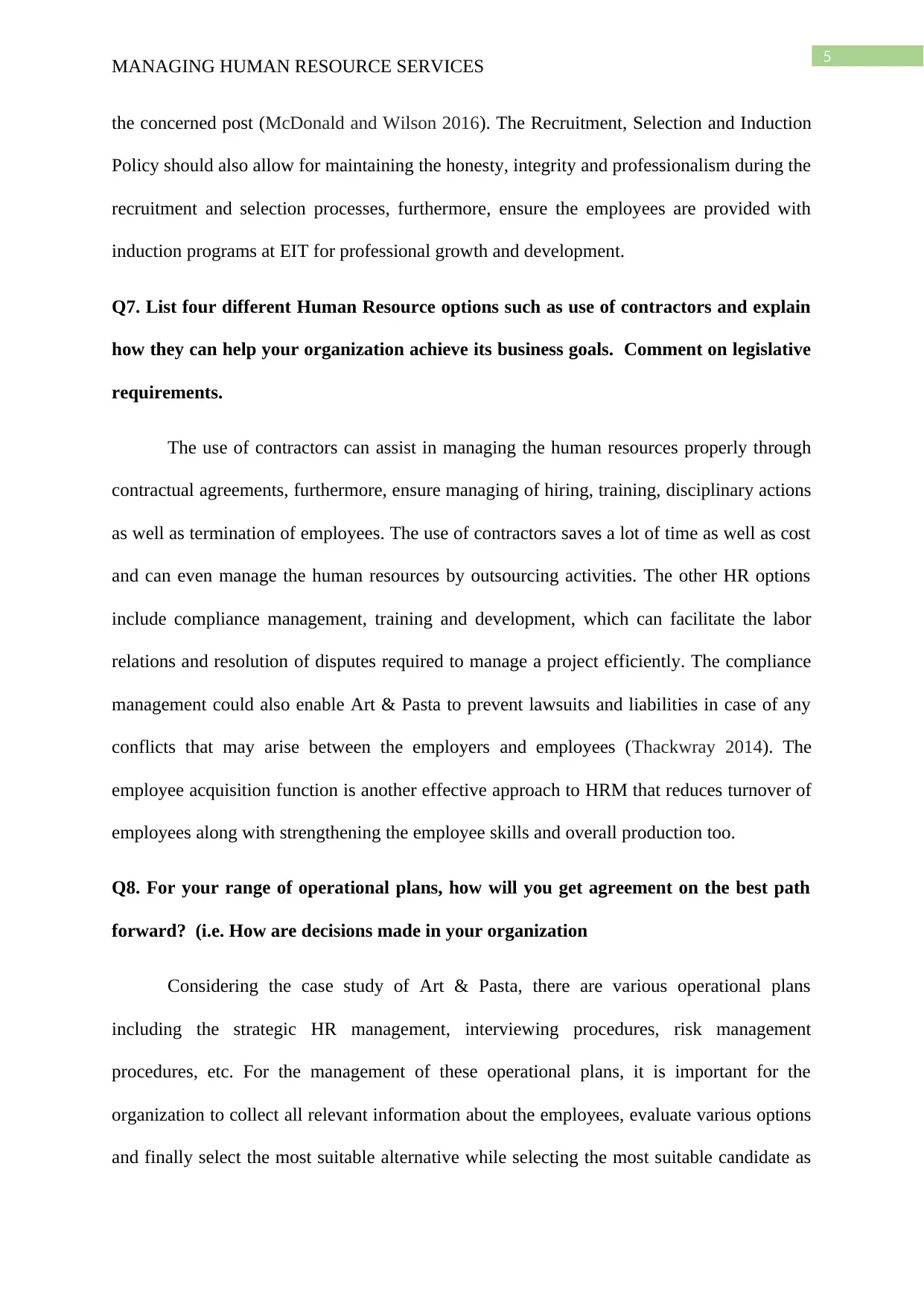
5
MANAGING HUMAN RESOURCE SERVICES
the concerned post (McDonald and Wilson 2016). The Recruitment, Selection and Induction
Policy should also allow for maintaining the honesty, integrity and professionalism during the
recruitment and selection processes, furthermore, ensure the employees are provided with
induction programs at EIT for professional growth and development.
Q7. List four different Human Resource options such as use of contractors and explain
how they can help your organization achieve its business goals. Comment on legislative
requirements.
The use of contractors can assist in managing the human resources properly through
contractual agreements, furthermore, ensure managing of hiring, training, disciplinary actions
as well as termination of employees. The use of contractors saves a lot of time as well as cost
and can even manage the human resources by outsourcing activities. The other HR options
include compliance management, training and development, which can facilitate the labor
relations and resolution of disputes required to manage a project efficiently. The compliance
management could also enable Art & Pasta to prevent lawsuits and liabilities in case of any
conflicts that may arise between the employers and employees (Thackwray 2014). The
employee acquisition function is another effective approach to HRM that reduces turnover of
employees along with strengthening the employee skills and overall production too.
Q8. For your range of operational plans, how will you get agreement on the best path
forward? (i.e. How are decisions made in your organization
Considering the case study of Art & Pasta, there are various operational plans
including the strategic HR management, interviewing procedures, risk management
procedures, etc. For the management of these operational plans, it is important for the
organization to collect all relevant information about the employees, evaluate various options
and finally select the most suitable alternative while selecting the most suitable candidate as
MANAGING HUMAN RESOURCE SERVICES
the concerned post (McDonald and Wilson 2016). The Recruitment, Selection and Induction
Policy should also allow for maintaining the honesty, integrity and professionalism during the
recruitment and selection processes, furthermore, ensure the employees are provided with
induction programs at EIT for professional growth and development.
Q7. List four different Human Resource options such as use of contractors and explain
how they can help your organization achieve its business goals. Comment on legislative
requirements.
The use of contractors can assist in managing the human resources properly through
contractual agreements, furthermore, ensure managing of hiring, training, disciplinary actions
as well as termination of employees. The use of contractors saves a lot of time as well as cost
and can even manage the human resources by outsourcing activities. The other HR options
include compliance management, training and development, which can facilitate the labor
relations and resolution of disputes required to manage a project efficiently. The compliance
management could also enable Art & Pasta to prevent lawsuits and liabilities in case of any
conflicts that may arise between the employers and employees (Thackwray 2014). The
employee acquisition function is another effective approach to HRM that reduces turnover of
employees along with strengthening the employee skills and overall production too.
Q8. For your range of operational plans, how will you get agreement on the best path
forward? (i.e. How are decisions made in your organization
Considering the case study of Art & Pasta, there are various operational plans
including the strategic HR management, interviewing procedures, risk management
procedures, etc. For the management of these operational plans, it is important for the
organization to collect all relevant information about the employees, evaluate various options
and finally select the most suitable alternative while selecting the most suitable candidate as
⊘ This is a preview!⊘
Do you want full access?
Subscribe today to unlock all pages.

Trusted by 1+ million students worldwide
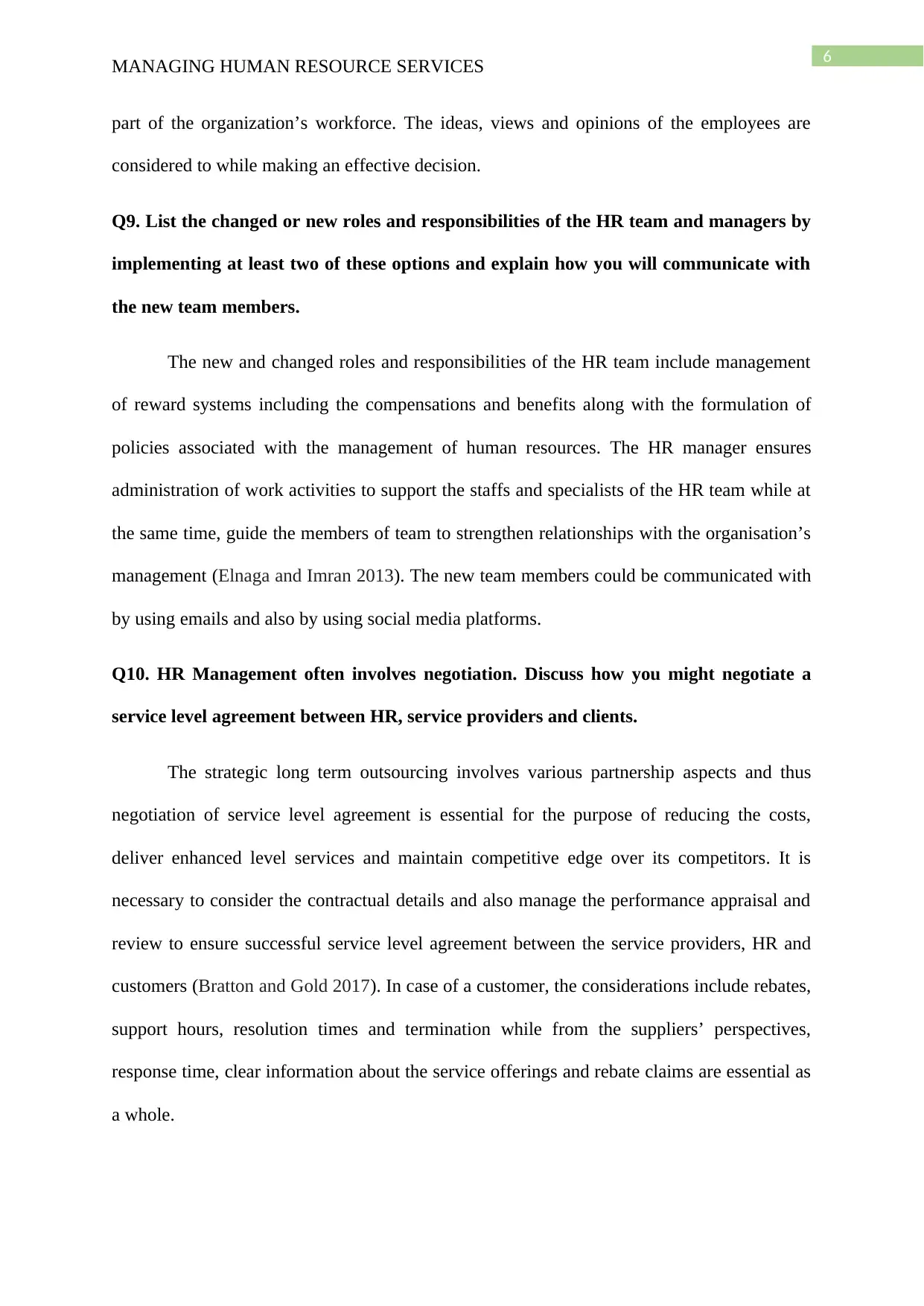
6
MANAGING HUMAN RESOURCE SERVICES
part of the organization’s workforce. The ideas, views and opinions of the employees are
considered to while making an effective decision.
Q9. List the changed or new roles and responsibilities of the HR team and managers by
implementing at least two of these options and explain how you will communicate with
the new team members.
The new and changed roles and responsibilities of the HR team include management
of reward systems including the compensations and benefits along with the formulation of
policies associated with the management of human resources. The HR manager ensures
administration of work activities to support the staffs and specialists of the HR team while at
the same time, guide the members of team to strengthen relationships with the organisation’s
management (Elnaga and Imran 2013). The new team members could be communicated with
by using emails and also by using social media platforms.
Q10. HR Management often involves negotiation. Discuss how you might negotiate a
service level agreement between HR, service providers and clients.
The strategic long term outsourcing involves various partnership aspects and thus
negotiation of service level agreement is essential for the purpose of reducing the costs,
deliver enhanced level services and maintain competitive edge over its competitors. It is
necessary to consider the contractual details and also manage the performance appraisal and
review to ensure successful service level agreement between the service providers, HR and
customers (Bratton and Gold 2017). In case of a customer, the considerations include rebates,
support hours, resolution times and termination while from the suppliers’ perspectives,
response time, clear information about the service offerings and rebate claims are essential as
a whole.
MANAGING HUMAN RESOURCE SERVICES
part of the organization’s workforce. The ideas, views and opinions of the employees are
considered to while making an effective decision.
Q9. List the changed or new roles and responsibilities of the HR team and managers by
implementing at least two of these options and explain how you will communicate with
the new team members.
The new and changed roles and responsibilities of the HR team include management
of reward systems including the compensations and benefits along with the formulation of
policies associated with the management of human resources. The HR manager ensures
administration of work activities to support the staffs and specialists of the HR team while at
the same time, guide the members of team to strengthen relationships with the organisation’s
management (Elnaga and Imran 2013). The new team members could be communicated with
by using emails and also by using social media platforms.
Q10. HR Management often involves negotiation. Discuss how you might negotiate a
service level agreement between HR, service providers and clients.
The strategic long term outsourcing involves various partnership aspects and thus
negotiation of service level agreement is essential for the purpose of reducing the costs,
deliver enhanced level services and maintain competitive edge over its competitors. It is
necessary to consider the contractual details and also manage the performance appraisal and
review to ensure successful service level agreement between the service providers, HR and
customers (Bratton and Gold 2017). In case of a customer, the considerations include rebates,
support hours, resolution times and termination while from the suppliers’ perspectives,
response time, clear information about the service offerings and rebate claims are essential as
a whole.
Paraphrase This Document
Need a fresh take? Get an instant paraphrase of this document with our AI Paraphraser
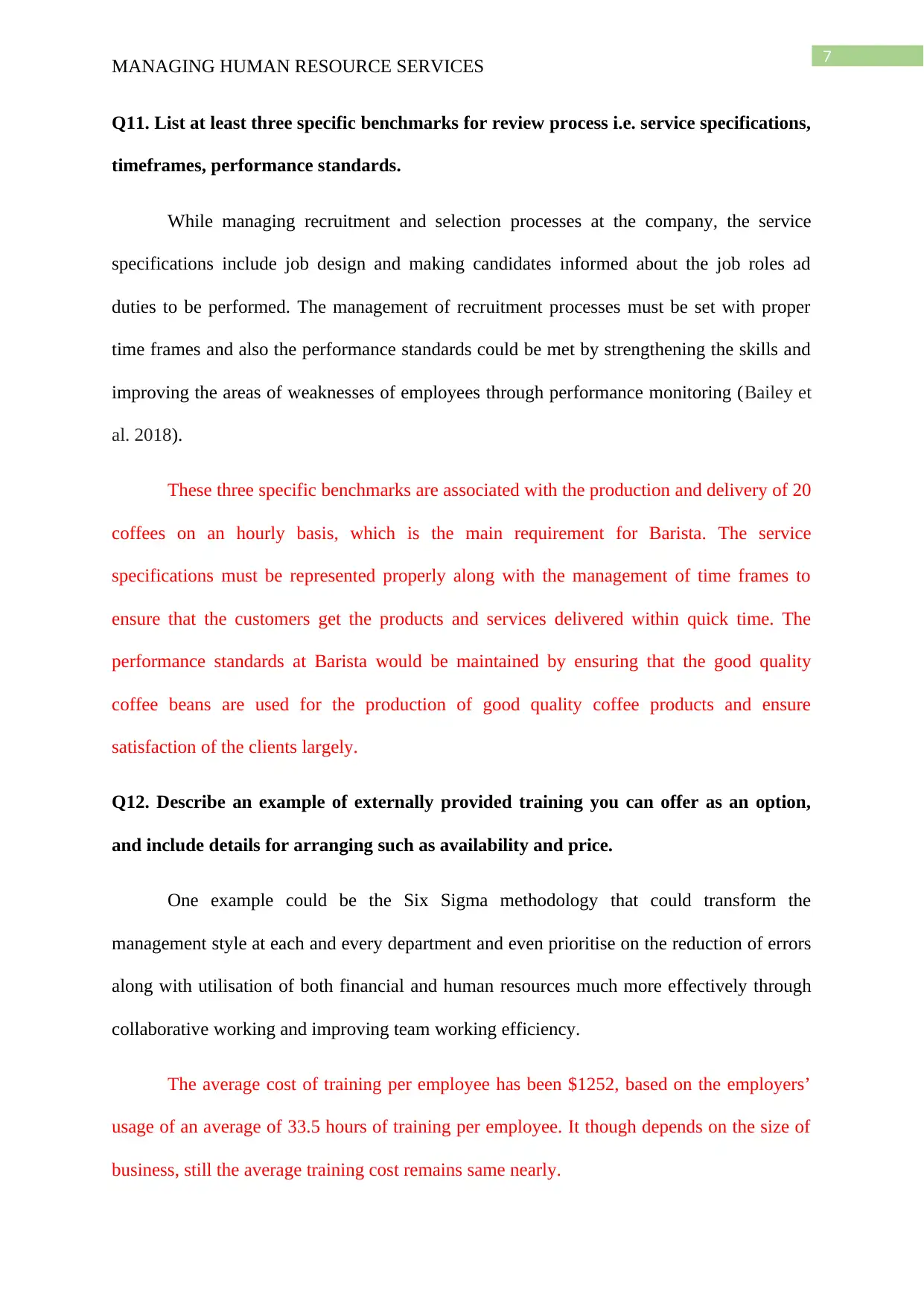
7
MANAGING HUMAN RESOURCE SERVICES
Q11. List at least three specific benchmarks for review process i.e. service specifications,
timeframes, performance standards.
While managing recruitment and selection processes at the company, the service
specifications include job design and making candidates informed about the job roles ad
duties to be performed. The management of recruitment processes must be set with proper
time frames and also the performance standards could be met by strengthening the skills and
improving the areas of weaknesses of employees through performance monitoring (Bailey et
al. 2018).
These three specific benchmarks are associated with the production and delivery of 20
coffees on an hourly basis, which is the main requirement for Barista. The service
specifications must be represented properly along with the management of time frames to
ensure that the customers get the products and services delivered within quick time. The
performance standards at Barista would be maintained by ensuring that the good quality
coffee beans are used for the production of good quality coffee products and ensure
satisfaction of the clients largely.
Q12. Describe an example of externally provided training you can offer as an option,
and include details for arranging such as availability and price.
One example could be the Six Sigma methodology that could transform the
management style at each and every department and even prioritise on the reduction of errors
along with utilisation of both financial and human resources much more effectively through
collaborative working and improving team working efficiency.
The average cost of training per employee has been $1252, based on the employers’
usage of an average of 33.5 hours of training per employee. It though depends on the size of
business, still the average training cost remains same nearly.
MANAGING HUMAN RESOURCE SERVICES
Q11. List at least three specific benchmarks for review process i.e. service specifications,
timeframes, performance standards.
While managing recruitment and selection processes at the company, the service
specifications include job design and making candidates informed about the job roles ad
duties to be performed. The management of recruitment processes must be set with proper
time frames and also the performance standards could be met by strengthening the skills and
improving the areas of weaknesses of employees through performance monitoring (Bailey et
al. 2018).
These three specific benchmarks are associated with the production and delivery of 20
coffees on an hourly basis, which is the main requirement for Barista. The service
specifications must be represented properly along with the management of time frames to
ensure that the customers get the products and services delivered within quick time. The
performance standards at Barista would be maintained by ensuring that the good quality
coffee beans are used for the production of good quality coffee products and ensure
satisfaction of the clients largely.
Q12. Describe an example of externally provided training you can offer as an option,
and include details for arranging such as availability and price.
One example could be the Six Sigma methodology that could transform the
management style at each and every department and even prioritise on the reduction of errors
along with utilisation of both financial and human resources much more effectively through
collaborative working and improving team working efficiency.
The average cost of training per employee has been $1252, based on the employers’
usage of an average of 33.5 hours of training per employee. It though depends on the size of
business, still the average training cost remains same nearly.
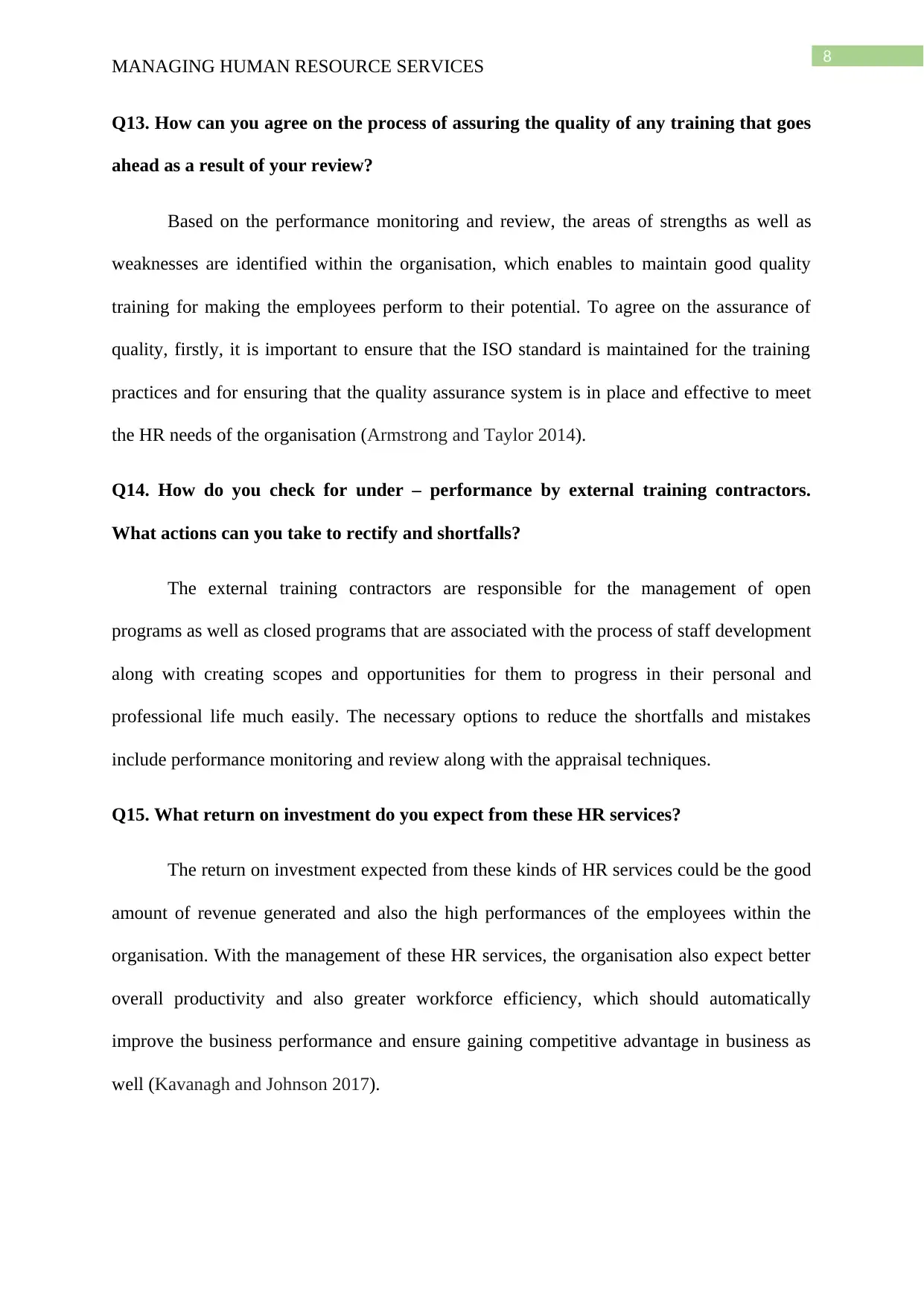
8
MANAGING HUMAN RESOURCE SERVICES
Q13. How can you agree on the process of assuring the quality of any training that goes
ahead as a result of your review?
Based on the performance monitoring and review, the areas of strengths as well as
weaknesses are identified within the organisation, which enables to maintain good quality
training for making the employees perform to their potential. To agree on the assurance of
quality, firstly, it is important to ensure that the ISO standard is maintained for the training
practices and for ensuring that the quality assurance system is in place and effective to meet
the HR needs of the organisation (Armstrong and Taylor 2014).
Q14. How do you check for under – performance by external training contractors.
What actions can you take to rectify and shortfalls?
The external training contractors are responsible for the management of open
programs as well as closed programs that are associated with the process of staff development
along with creating scopes and opportunities for them to progress in their personal and
professional life much easily. The necessary options to reduce the shortfalls and mistakes
include performance monitoring and review along with the appraisal techniques.
Q15. What return on investment do you expect from these HR services?
The return on investment expected from these kinds of HR services could be the good
amount of revenue generated and also the high performances of the employees within the
organisation. With the management of these HR services, the organisation also expect better
overall productivity and also greater workforce efficiency, which should automatically
improve the business performance and ensure gaining competitive advantage in business as
well (Kavanagh and Johnson 2017).
MANAGING HUMAN RESOURCE SERVICES
Q13. How can you agree on the process of assuring the quality of any training that goes
ahead as a result of your review?
Based on the performance monitoring and review, the areas of strengths as well as
weaknesses are identified within the organisation, which enables to maintain good quality
training for making the employees perform to their potential. To agree on the assurance of
quality, firstly, it is important to ensure that the ISO standard is maintained for the training
practices and for ensuring that the quality assurance system is in place and effective to meet
the HR needs of the organisation (Armstrong and Taylor 2014).
Q14. How do you check for under – performance by external training contractors.
What actions can you take to rectify and shortfalls?
The external training contractors are responsible for the management of open
programs as well as closed programs that are associated with the process of staff development
along with creating scopes and opportunities for them to progress in their personal and
professional life much easily. The necessary options to reduce the shortfalls and mistakes
include performance monitoring and review along with the appraisal techniques.
Q15. What return on investment do you expect from these HR services?
The return on investment expected from these kinds of HR services could be the good
amount of revenue generated and also the high performances of the employees within the
organisation. With the management of these HR services, the organisation also expect better
overall productivity and also greater workforce efficiency, which should automatically
improve the business performance and ensure gaining competitive advantage in business as
well (Kavanagh and Johnson 2017).
⊘ This is a preview!⊘
Do you want full access?
Subscribe today to unlock all pages.

Trusted by 1+ million students worldwide
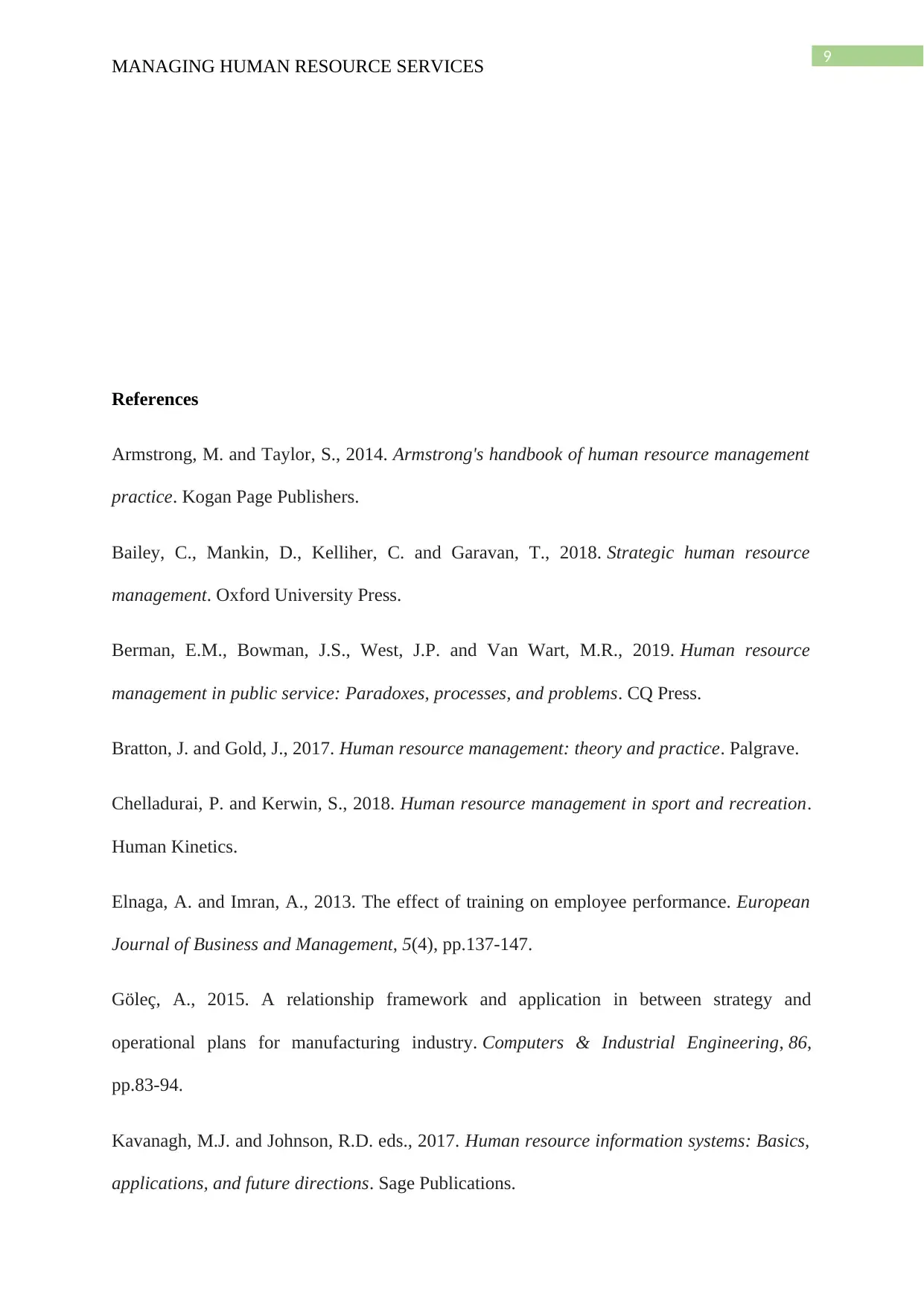
9
MANAGING HUMAN RESOURCE SERVICES
References
Armstrong, M. and Taylor, S., 2014. Armstrong's handbook of human resource management
practice. Kogan Page Publishers.
Bailey, C., Mankin, D., Kelliher, C. and Garavan, T., 2018. Strategic human resource
management. Oxford University Press.
Berman, E.M., Bowman, J.S., West, J.P. and Van Wart, M.R., 2019. Human resource
management in public service: Paradoxes, processes, and problems. CQ Press.
Bratton, J. and Gold, J., 2017. Human resource management: theory and practice. Palgrave.
Chelladurai, P. and Kerwin, S., 2018. Human resource management in sport and recreation.
Human Kinetics.
Elnaga, A. and Imran, A., 2013. The effect of training on employee performance. European
Journal of Business and Management, 5(4), pp.137-147.
Göleç, A., 2015. A relationship framework and application in between strategy and
operational plans for manufacturing industry. Computers & Industrial Engineering, 86,
pp.83-94.
Kavanagh, M.J. and Johnson, R.D. eds., 2017. Human resource information systems: Basics,
applications, and future directions. Sage Publications.
MANAGING HUMAN RESOURCE SERVICES
References
Armstrong, M. and Taylor, S., 2014. Armstrong's handbook of human resource management
practice. Kogan Page Publishers.
Bailey, C., Mankin, D., Kelliher, C. and Garavan, T., 2018. Strategic human resource
management. Oxford University Press.
Berman, E.M., Bowman, J.S., West, J.P. and Van Wart, M.R., 2019. Human resource
management in public service: Paradoxes, processes, and problems. CQ Press.
Bratton, J. and Gold, J., 2017. Human resource management: theory and practice. Palgrave.
Chelladurai, P. and Kerwin, S., 2018. Human resource management in sport and recreation.
Human Kinetics.
Elnaga, A. and Imran, A., 2013. The effect of training on employee performance. European
Journal of Business and Management, 5(4), pp.137-147.
Göleç, A., 2015. A relationship framework and application in between strategy and
operational plans for manufacturing industry. Computers & Industrial Engineering, 86,
pp.83-94.
Kavanagh, M.J. and Johnson, R.D. eds., 2017. Human resource information systems: Basics,
applications, and future directions. Sage Publications.
Paraphrase This Document
Need a fresh take? Get an instant paraphrase of this document with our AI Paraphraser
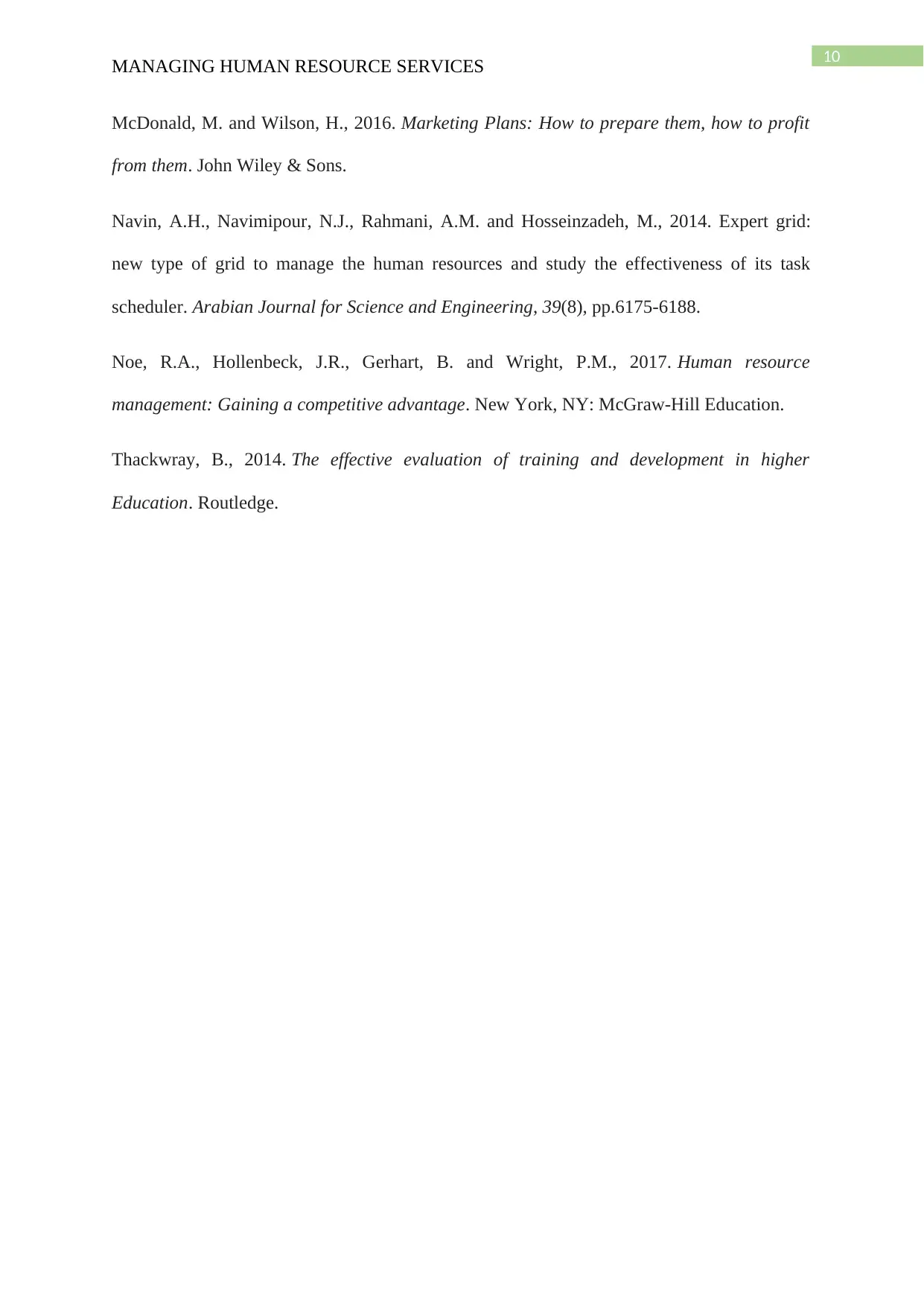
10
MANAGING HUMAN RESOURCE SERVICES
McDonald, M. and Wilson, H., 2016. Marketing Plans: How to prepare them, how to profit
from them. John Wiley & Sons.
Navin, A.H., Navimipour, N.J., Rahmani, A.M. and Hosseinzadeh, M., 2014. Expert grid:
new type of grid to manage the human resources and study the effectiveness of its task
scheduler. Arabian Journal for Science and Engineering, 39(8), pp.6175-6188.
Noe, R.A., Hollenbeck, J.R., Gerhart, B. and Wright, P.M., 2017. Human resource
management: Gaining a competitive advantage. New York, NY: McGraw-Hill Education.
Thackwray, B., 2014. The effective evaluation of training and development in higher
Education. Routledge.
MANAGING HUMAN RESOURCE SERVICES
McDonald, M. and Wilson, H., 2016. Marketing Plans: How to prepare them, how to profit
from them. John Wiley & Sons.
Navin, A.H., Navimipour, N.J., Rahmani, A.M. and Hosseinzadeh, M., 2014. Expert grid:
new type of grid to manage the human resources and study the effectiveness of its task
scheduler. Arabian Journal for Science and Engineering, 39(8), pp.6175-6188.
Noe, R.A., Hollenbeck, J.R., Gerhart, B. and Wright, P.M., 2017. Human resource
management: Gaining a competitive advantage. New York, NY: McGraw-Hill Education.
Thackwray, B., 2014. The effective evaluation of training and development in higher
Education. Routledge.
1 out of 11
Related Documents
Your All-in-One AI-Powered Toolkit for Academic Success.
+13062052269
info@desklib.com
Available 24*7 on WhatsApp / Email
![[object Object]](/_next/static/media/star-bottom.7253800d.svg)
Unlock your academic potential
Copyright © 2020–2025 A2Z Services. All Rights Reserved. Developed and managed by ZUCOL.





